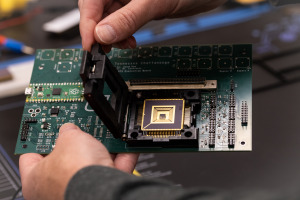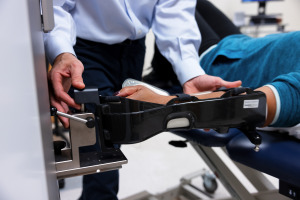For More Information
Indiana University is taking bold steps to boost Indiana’s global leadership and impact in the life sciences and biotechnology, as well as microelectronics and nanotechnology, as part of more than $350 million of investments in research, in-demand degree programs, and economic development initiatives.
The university’s investment will boost the growth of the microelectronics industry in Indiana and across the U.S. and accelerate innovative solutions to major national security challenges through enhanced collaboration with Naval Surface Warfare Center, Crane Division.
Through innovative research, IU will address emerging semiconductor technologies, drive talent development and respond to critical defense needs. Funds will be directed to faculty hiring, facilities and equipment, as well as strategic initiatives focused on advancements in microelectronics, nanotechnology, artificial intelligence, machine learning and cybersecurity. IU’s investments will also support partnerships with defense contractors and companies working to develop dual-use technologies — those that can be used in defense and civilian applications.
“The significant investments we’re making reflect a shared mission between IU and NSWC Crane and will strengthen IU’s national leadership, further develop Indiana’s microelectronics sector and drive our state’s economic competitiveness,” IU President Pamela Whitten said.
IU’s investments in microelectronics and to support its partnership with NSWC Crane and industry include the ambitious Faculty 100 hiring initiative, expansion and upgrades to laboratories and other facilities, as well as implementing new degree programs to train students in microelectronics and nanofabrication.
New research institutes at IU Indianapolis, expanded recruitment of preeminent researchers to IU Bloomington
In a similar show of national strength, IU is targeting more than $250 million to advance scientific discoveries aimed at curing and treating diseases and improving human health, while cementing Indiana’s position as a global leader in life sciences and biotechnology innovation.

IU President Pamela Whitten announced the funding commitments, which rival the largest investments made in these areas by the nation’s leading public and private research universities, during her annual State of the University address. The funding for two new research institutes, new faculty appointments in the life sciences, new and renovated facilities, and major education and research initiatives represents one of IU’s largest strategic investments in life sciences, human health and biotechnology.
“Indiana University’s multimillion-dollar strategic investments in the biosciences will ensure IU continues to be at the forefront of driving life-changing discoveries and advancing a robust health care and life sciences ecosystem in Indianapolis and across the Hoosier state,” Whitten said.
Drawing on decades of IU’s leadership in health sciences and medicine and the expertise of top-tier faculty on its core research campuses in Bloomington and Indianapolis, as well as the nation’s largest medical school, IU will launch the Convergent Bioscience and Technology Institute and the Institute for Human Health and Wellbeing. Aligned to the IU 2030 strategic plan, these Indianapolis-based institutes will drive transformative research in the areas of health, medicine, life sciences and technology, while equipping IU to nimbly address emerging disciplines.
The new institutes will be located within the new IU Science and Technology Corridor at IU Indianapolis but will foster faculty collaboration across IU. As part of the SciTech Corridor, they will advance STEM education and curriculum for Hoosiers and accelerate the transformation of IU Indianapolis into one of the nation’s leading urban public research universities.
Whitten outlined IU’s current and future financial commitments — which build upon funding provided to IU by the Indiana General Assembly — targeted at attracting the best scientific minds in the nation to IU, designing and developing new teaching and research initiatives in the biosciences, and advancing collaborative activities with key local, state and national partners.

These commitments over the next several years include investing $60 million in appropriations from the state of Indiana to expand and renovate STEM research and laboratory space and interdisciplinary research facilities, supporting $46.1 million in faculty startup costs for new IU Bloomington faculty to accelerate innovative and interdisciplinary health science research, and expand federal grants and contracts. IU will also establish a series of high-demand academic degree programs to complement the new research institutes at IU Indianapolis and areas of life science excellence in Bloomington, offering new opportunities for students.
During her address, Whitten highlighted the potential of IU’s new research institutes in Indianapolis to catalyze central Indiana’s growth in biosciences and biotechnology and shape the creation of healthier communities across the state.
“Collectively, IU’s resources and the university’s partners across our state make for a powerful formula that has transformed Indiana into a national and international center for bold exploration, innovation and transformative discoveries in the life sciences,” Whitten said. “We are cementing IU as a leader in shaping the future of this vital sector.”
What they are saying:
U.S. Sen. Todd Young: “This is very exciting news for IU, NSWC Crane and our entire state. Partnerships like this one between IU and NSWC Crane are pivotal to our national security and economic competitiveness. Today’s announcement is another example of how Hoosiers are leading the way in our modern economy.”
Indiana Gov. Eric J. Holcomb: “Indiana University’s continued financial commitment to invest in its Indianapolis campus strengthens our state’s health care and life science pipelines and will help drive further economic growth throughout the high-tech bioscience sector. IU is doubling down on its role as one of the top research institutions in the country, helping Indiana maintain our stronghold position as a global leader in life sciences and biotechnology innovation, which will ultimately lead to better health outcomes for Hoosier families and beyond.”
Melina Kennedy, CEO of the Central Indiana Corporate Partnership: “Indiana University has long been a great partner to BioCrossroads and the entire Hoosier life sciences sector. It’s also a key driver in incredible medical advances that have had huge global effects. We are thrilled to see this unprecedented level of additional investment. The two new research institutes located near the 16 Tech Innovation District will enhance a burgeoning research corridor in Indianapolis, and Bloomington campus growth will spur even more important discoveries. The expansion will further strengthen Indiana’s already robust and diverse life sciences sector, which contributed nearly $80 billion to the state’s economy last year.”
Dave Ricks, chair and CEO, Eli Lilly and Company: “I commend President Whitten on IU’s new investment in life sciences research and education. Lilly has always sought to attract the best talent in the world to help us make medicines for some of mankind’s most difficult health challenges. Investing in training and educating bright minds focused on improving health closer to home makes IU, Lilly, and the entire state of Indiana stronger.”
